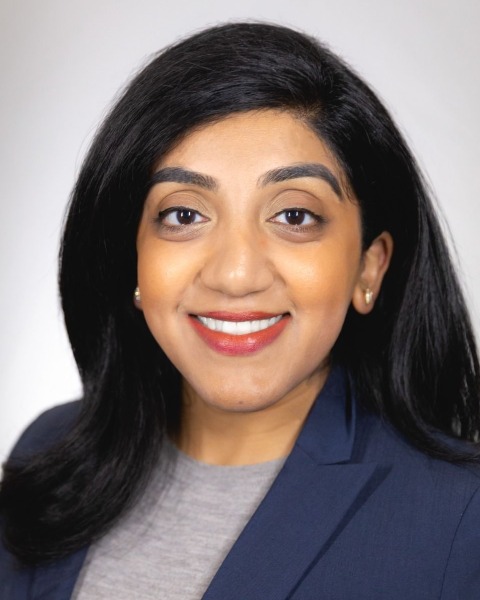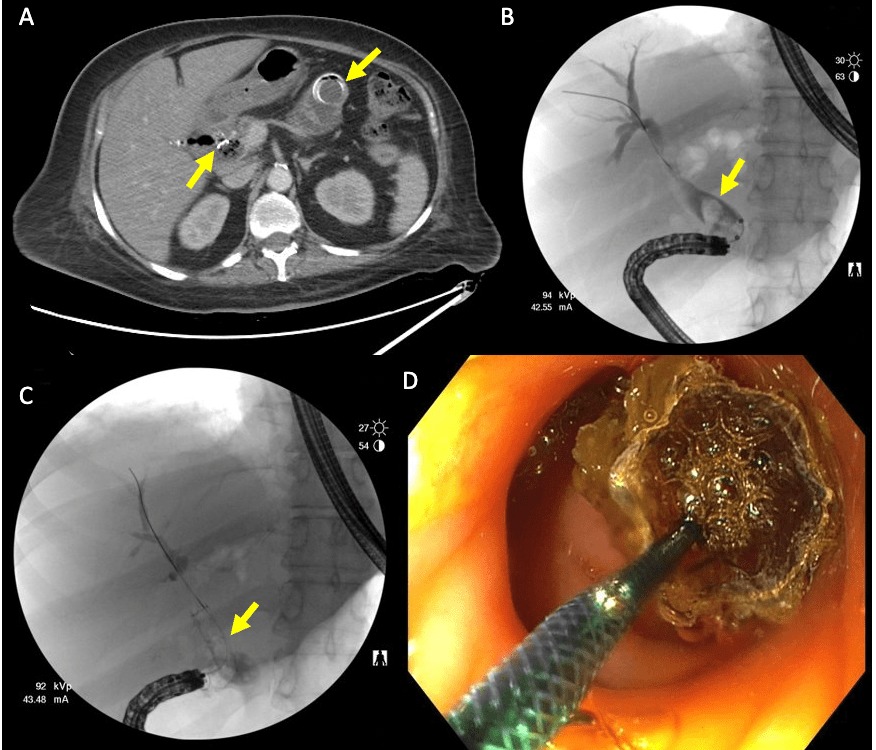Back


Poster Session E - Tuesday Afternoon
Category: Biliary/Pancreas
E0051 - Biliary Sump Syndrome Causing Cholangitis From Displaced EUS-choledochoduodenostomy Stent Migration, Salvaged With Cholangioscopy and Endoscopic Therapy
Tuesday, October 25, 2022
3:00 PM – 5:00 PM ET
Location: Crown Ballroom

Has Audio

Deepa Kumarjiguda, DO
Geisinger Health System
Danville, PA
Presenting Author(s)
Deepa Kumarjiguda, DO, Harrison R. Malcolm, JD, DO, Harshit S. Khara, MD, FACG, Jessica L. McKee, DO
Geisinger Health System, Danville, PA
Introduction: EUS-guided choledochoduodenostomy (EUS-CDD) is a great salvage procedure for relieving biliary obstruction from failed transpapillary biliary access, however, we describe a patient with EUS-CDD who developed a rare complication of choledochoduodenostomy stent migration causing recurrent biliary obstruction and cholangitis, salvaged with endoscopic intervention with repeat stenting.
Case Description/Methods: A 58-year-old female with pancreas head adenocarcinoma presented with gastric outlet and biliary obstruction. Both these conditions were successfully treated with same session EUS-CDD with a fully covered metal biliary stent, along with EUS-guided gastroenterostomy (EUS-GE) with 20 mm Axios stent. She now presented 5 months later with signs of recurrent biliary obstruction and cholangitis. Labs revealed elevated alkaline phosphatase 1986 U/L (normal 35-130), and total bilirubin 3.6 mg/dL (normal ≤ 1.2). Repeat CT scan showed a patent EUS-GE Axios stent, but outward migration of the EUS-CDD stent (Fig 1-A), causing recurrent biliary obstruction from food debris impaction in the dependent bile duct reservoir causing Sump Syndrome seen on repeat endoscopy and ERCP (Fig 1-B). We were able to salvage the EUS-CDD site with cholangioscopy and food disimpaction along with repeat Viabil fully covered metal biliary stent with anti-migration flaps placement via the existing EUS-CDD site (Fig 1-C & 1-D).
Discussion: Biliary sump syndrome is a rare long-term complication previously seen in surgical CDD patients due to food impaction in the distal CBD from the new anastomosis to act as a “sump,” a poorly drained reservoir making this prone to accumulation of debris, increasing chances of complications, such as biliary obstruction, abscess, and cholangitis. Our case highlights the importance of this rare phenomenon even in the new era of therapeutic EUS procedures, but with the caveat that it can be successfully treated with repeat endoscopic therapy, and thereby avoiding the need for surgery or percutaneous intervention.

Disclosures:
Deepa Kumarjiguda, DO, Harrison R. Malcolm, JD, DO, Harshit S. Khara, MD, FACG, Jessica L. McKee, DO. E0051 - Biliary Sump Syndrome Causing Cholangitis From Displaced EUS-choledochoduodenostomy Stent Migration, Salvaged With Cholangioscopy and Endoscopic Therapy, ACG 2022 Annual Scientific Meeting Abstracts. Charlotte, NC: American College of Gastroenterology.
Geisinger Health System, Danville, PA
Introduction: EUS-guided choledochoduodenostomy (EUS-CDD) is a great salvage procedure for relieving biliary obstruction from failed transpapillary biliary access, however, we describe a patient with EUS-CDD who developed a rare complication of choledochoduodenostomy stent migration causing recurrent biliary obstruction and cholangitis, salvaged with endoscopic intervention with repeat stenting.
Case Description/Methods: A 58-year-old female with pancreas head adenocarcinoma presented with gastric outlet and biliary obstruction. Both these conditions were successfully treated with same session EUS-CDD with a fully covered metal biliary stent, along with EUS-guided gastroenterostomy (EUS-GE) with 20 mm Axios stent. She now presented 5 months later with signs of recurrent biliary obstruction and cholangitis. Labs revealed elevated alkaline phosphatase 1986 U/L (normal 35-130), and total bilirubin 3.6 mg/dL (normal ≤ 1.2). Repeat CT scan showed a patent EUS-GE Axios stent, but outward migration of the EUS-CDD stent (Fig 1-A), causing recurrent biliary obstruction from food debris impaction in the dependent bile duct reservoir causing Sump Syndrome seen on repeat endoscopy and ERCP (Fig 1-B). We were able to salvage the EUS-CDD site with cholangioscopy and food disimpaction along with repeat Viabil fully covered metal biliary stent with anti-migration flaps placement via the existing EUS-CDD site (Fig 1-C & 1-D).
Discussion: Biliary sump syndrome is a rare long-term complication previously seen in surgical CDD patients due to food impaction in the distal CBD from the new anastomosis to act as a “sump,” a poorly drained reservoir making this prone to accumulation of debris, increasing chances of complications, such as biliary obstruction, abscess, and cholangitis. Our case highlights the importance of this rare phenomenon even in the new era of therapeutic EUS procedures, but with the caveat that it can be successfully treated with repeat endoscopic therapy, and thereby avoiding the need for surgery or percutaneous intervention.

Figure: Figure 1.
A. CT abdomen with left arrow showing displaced CDD stent and right showing patent Axios EUS-GE stent.
B. ERCP showing debris obstructing distal CBD causing reservoir “Sump Syndrome”
C. ERCP with placement of new Viabil stent with antimigration flaps for salvage of EUS-CDD.
D. Endoscopic image of new Viabil stent with antimigration flaps.
A. CT abdomen with left arrow showing displaced CDD stent and right showing patent Axios EUS-GE stent.
B. ERCP showing debris obstructing distal CBD causing reservoir “Sump Syndrome”
C. ERCP with placement of new Viabil stent with antimigration flaps for salvage of EUS-CDD.
D. Endoscopic image of new Viabil stent with antimigration flaps.
Disclosures:
Deepa Kumarjiguda indicated no relevant financial relationships.
Harrison Malcolm indicated no relevant financial relationships.
Harshit Khara indicated no relevant financial relationships.
Jessica McKee indicated no relevant financial relationships.
Deepa Kumarjiguda, DO, Harrison R. Malcolm, JD, DO, Harshit S. Khara, MD, FACG, Jessica L. McKee, DO. E0051 - Biliary Sump Syndrome Causing Cholangitis From Displaced EUS-choledochoduodenostomy Stent Migration, Salvaged With Cholangioscopy and Endoscopic Therapy, ACG 2022 Annual Scientific Meeting Abstracts. Charlotte, NC: American College of Gastroenterology.
